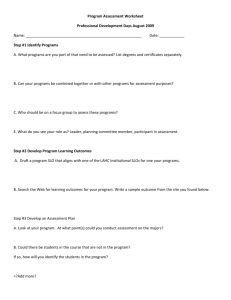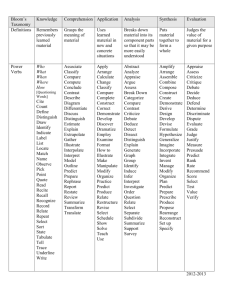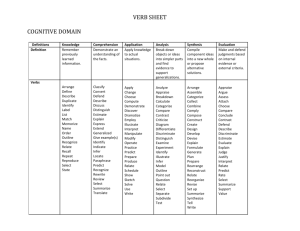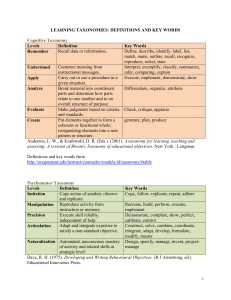Blooms Taxonomy
advertisement
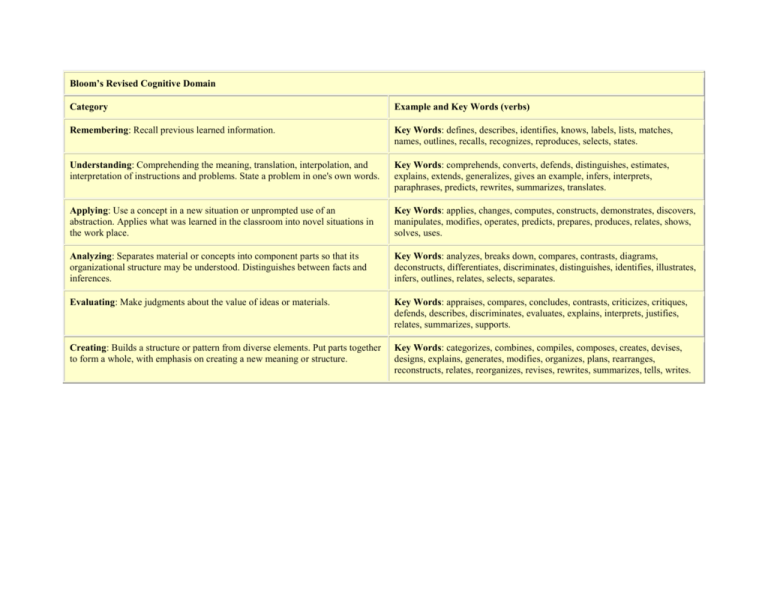
Bloom’s Revised Cognitive Domain Category Example and Key Words (verbs) Remembering: Recall previous learned information. Key Words: defines, describes, identifies, knows, labels, lists, matches, names, outlines, recalls, recognizes, reproduces, selects, states. Understanding: Comprehending the meaning, translation, interpolation, and interpretation of instructions and problems. State a problem in one's own words. Key Words: comprehends, converts, defends, distinguishes, estimates, explains, extends, generalizes, gives an example, infers, interprets, paraphrases, predicts, rewrites, summarizes, translates. Applying: Use a concept in a new situation or unprompted use of an abstraction. Applies what was learned in the classroom into novel situations in the work place. Key Words: applies, changes, computes, constructs, demonstrates, discovers, manipulates, modifies, operates, predicts, prepares, produces, relates, shows, solves, uses. Analyzing: Separates material or concepts into component parts so that its organizational structure may be understood. Distinguishes between facts and inferences. Key Words: analyzes, breaks down, compares, contrasts, diagrams, deconstructs, differentiates, discriminates, distinguishes, identifies, illustrates, infers, outlines, relates, selects, separates. Evaluating: Make judgments about the value of ideas or materials. Key Words: appraises, compares, concludes, contrasts, criticizes, critiques, defends, describes, discriminates, evaluates, explains, interprets, justifies, relates, summarizes, supports. Creating: Builds a structure or pattern from diverse elements. Put parts together to form a whole, with emphasis on creating a new meaning or structure. Key Words: categorizes, combines, compiles, composes, creates, devises, designs, explains, generates, modifies, organizes, plans, rearranges, reconstructs, relates, reorganizes, revises, rewrites, summarizes, tells, writes. Bloom’s Revised Psychomotor Domain Category Example and Key Words (verbs) Perception (awareness): The ability to use sensory cues to guide motor activity. This ranges from sensory stimulation, through cue selection, to translation. Key Words: chooses, describes, detects, differentiates, distinguishes, identifies, isolates, relates, selects. Set: Readiness to act. It includes mental, physical, and emotional sets. These three sets are dispositions that predetermine a person's response to different situations (sometimes called mindsets). Key Words: begins, displays, explains, moves, proceeds, reacts, shows, states, volunteers. Guided Response: The early stages in learning a complex skill that includes imitation and trial and error. Adequacy of performance is achieved by practicing. Key Words: copies, traces, follows, react, reproduce, responds Mechanism (basic proficiency): This is the intermediate stage in learning a complex skill. Learned responses have become habitual and the movements can be performed with some confidence and proficiency. Key Words: assembles, calibrates, constructs, dismantles, displays, fastens, fixes, grinds, heats, manipulates, measures, mends, mixes, organizes, sketches. Complex Overt Response (Expert): The skillful performance of motor acts that involve complex movement patterns. Proficiency is indicated by a quick, accurate, and highly coordinated performance, requiring a minimum of energy. This category includes performing without hesitation, and automatic performance. For example, players are often utter sounds of satisfaction or expletives as soon as they hit a tennis ball or throw a football, because they can tell by the feel of the act what the result will produce. Key Words: assembles, builds, calibrates, constructs, dismantles, displays, fastens, fixes, grinds, heats, manipulates, measures, mends, mixes, organizes, sketches. NOTE: The Key Words are the same as Mechanism, but will have adverbs or adjectives that indicate that the performance is quicker, better, more accurate, etc. Adaptation: Skills are well developed and the individual can modify movement patterns to fit special requirements. Key Words: adapts, alters, changes, rearranges, reorganizes, revises, varies. Origination: Creating new movement patterns to fit a particular situation or specific problem. Learning outcomes emphasize creativity based upon highly developed skills. Key Words: arranges, builds, combines, composes, constructs, creates, designs, initiate, makes, originates. Bloom’s Revised Affective Domain Category Example and Key Words (verbs) Receiving Phenomena: Awareness, willingness to hear, selected attention. Key Words: asks, chooses, describes, follows, gives, holds, identifies, locates, names, points to, selects, sits, erects, replies, uses. Responding to Phenomena: Active participation on the part of the learners. Attends and reacts to a particular phenomenon. Learning outcomes may emphasize compliance in responding, willingness to respond, or satisfaction in responding (motivation). Key Words: answers, assists, aids, complies, conforms, discusses, greets, helps, labels, performs, practices, presents, reads, recites, reports, selects, tells, writes. Valuing: The worth or value a person attaches to a particular object, phenomenon, or behavior. This ranges from simple acceptance to the more complex state of commitment. Valuing is based on the internalization of a set of specified values, while clues to these values are expressed in the learner's overt behavior and are often identifiable. Key Words: completes, demonstrates, differentiates, explains, follows, forms, initiates, invites, joins, justifies, proposes, reads, reports, selects, shares, studies, works. Organization: Organizes values into priorities by contrasting different values, resolving conflicts between them, and creating an unique value system. The emphasis is on comparing, relating, and synthesizing values. Key Words: adheres, alters, arranges, combines, compares, completes, defends, explains, formulates, generalizes, identifies, integrates, modifies, orders, organizes, prepares, relates, synthesizes. Internalizing values (characterization): Has a value system that controls their behavior. The behavior is pervasive, consistent, predictable, and most importantly, characteristic of the learner. Instructional objectives are concerned with the student's general patterns of adjustment (personal, social, emotional). Key Words: acts, discriminates, displays, influences, listens, modifies, performs, practices, proposes, qualifies, questions, revises, serves, solves, verifies.
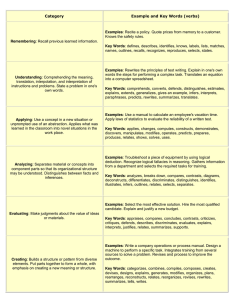
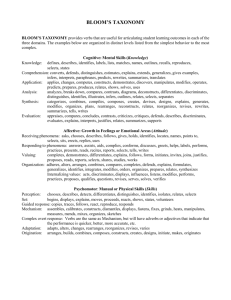
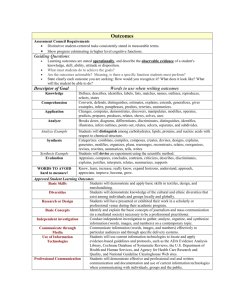
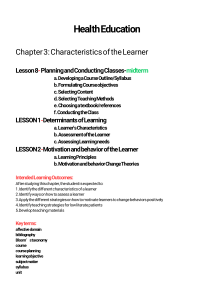
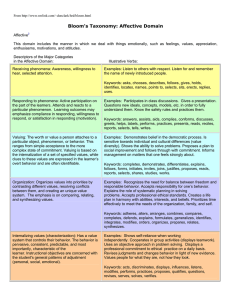
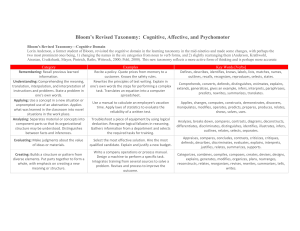
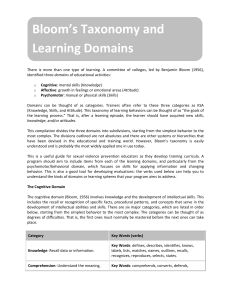
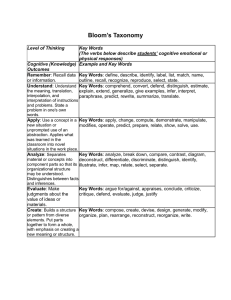
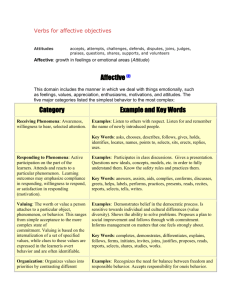
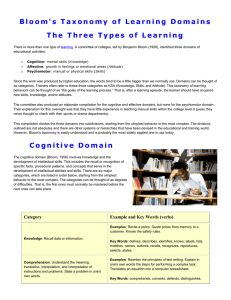
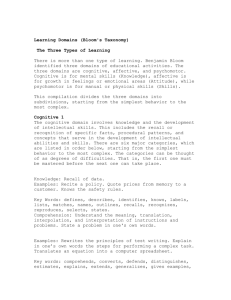
![Oral Presentation: Structure[1]](http://s3.studylib.net/store/data/007247236_1-34a6e756a1f0b2fa782e92987ee4471f-300x300.png)
